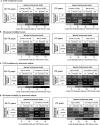Changes in Cardiovascular Risk Factors and Cardiovascular Events in the Elderly Population
- PMID: 33998260
- PMCID: PMC8483545
- DOI: 10.1161/JAHA.120.019482
Changes in Cardiovascular Risk Factors and Cardiovascular Events in the Elderly Population
Abstract
Background This study examines changes in the ideal cardiovascular health (CVH) status and whether these changes are associated with incident cardiovascular disease (CVD) and mortality in the elderly Asian population. Methods and Results In the Korea National Health Insurance Service-Senior cohort aged ≥60 years, 208 673 participants without prior CVD, including 109 431 who showed changes in CVH status, were assessed. The association of the changes in cardiovascular risk factors with incident CVD was assessed from 2004 to 2014 in the elderly (aged 60-74 years) and very elderly (≥75 years) groups. During the follow-up period (7.1 years for CVD and 7.2 years for mortality), 19 429 incident CVD events and 24 225 deaths occurred. In both the elderly and very elderly participants, higher CVH status resulted in a lower risk of CVD and mortality. In the very elderly participants, compared with consistently low CVH, consistently high CVH (subhazard ratio, 0.41; 95% CI, 0.23-0.73) was associated with a lower risk of CVD. This trend was consistently observed in the elderly population. In the very elderly participants, total cholesterol level was not informative enough for the prediction of CVD events. In both the elderly and very elderly groups, body mass index and total cholesterol were not informative enough for the prediction of all-cause mortality. Conclusions In both the elderly and very elderly Asian populations without CVD, a consistent relationship was observed between the improvement of a composite metric of CVH and the reduced risk of CVD. Body mass index and total cholesterol were not informative enough for the prediction of all-cause mortality in both the elderly and very elderly groups.
Keywords: cardiovascular disease; cardiovascular health; elderly; mortality.
Conflict of interest statement
Dr Joung has served as a speaker for Bayer, BMS/Pfizer, Medtronic, and Daiichi‐Sankyo; and received research funds from Medtronic and Abbott. No fees were directly or personally received. The remaining authors have no disclosures to report.
Figures



Similar articles
-
Association of the Duration of Ideal Cardiovascular Health Through Adulthood With Cardiometabolic Outcomes and Mortality in the Framingham Offspring Study.JAMA Cardiol. 2020 May 1;5(5):549-556. doi: 10.1001/jamacardio.2020.0109. JAMA Cardiol. 2020. PMID: 32159731 Free PMC article.
-
Association of cardiovascular health metrics with all-cause and cardiovascular disease mortality in chronic kidney disease: A cohort study.Nutr Metab Cardiovasc Dis. 2024 Aug;34(8):1837-1845. doi: 10.1016/j.numecd.2024.03.024. Epub 2024 Mar 23. Nutr Metab Cardiovasc Dis. 2024. PMID: 38760189
-
Ideal Cardiovascular Health Metric and Its Change With Lifetime Risk of Cardiovascular Diseases: A Prospective Cohort Study.J Am Heart Assoc. 2021 Nov 16;10(22):e022502. doi: 10.1161/JAHA.121.022502. Epub 2021 Nov 10. J Am Heart Assoc. 2021. PMID: 34755533 Free PMC article.
-
Association between ideal cardiovascular health metrics and risk of cardiovascular events or mortality: A meta-analysis of prospective studies.Clin Cardiol. 2017 Dec;40(12):1339-1346. doi: 10.1002/clc.22836. Epub 2017 Dec 26. Clin Cardiol. 2017. PMID: 29278429 Free PMC article. Review.
-
Ideal Cardiovascular Health and Risk of Cardiovascular Events or Mortality: A Systematic Review and Meta-Analysis of Prospective Studies.J Clin Med. 2023 Jun 30;12(13):4417. doi: 10.3390/jcm12134417. J Clin Med. 2023. PMID: 37445451 Free PMC article. Review.
Cited by
-
Association between exercise habit changes and mortality following a cardiovascular event.Heart. 2022 Nov 24;108(24):1945-1951. doi: 10.1136/heartjnl-2022-320882. Heart. 2022. PMID: 35589378 Free PMC article.
-
Association of changes in cardiovascular health levels with incident cardiovascular events and mortality in patients with atrial fibrillation.Clin Res Cardiol. 2023 Jun;112(6):724-735. doi: 10.1007/s00392-022-02058-3. Epub 2022 Jul 13. Clin Res Cardiol. 2023. PMID: 35829750
-
Association of cardiovascular health at old age with all-cause mortality: a prospective cohort study in China.BMC Geriatr. 2023 Jul 15;23(1):437. doi: 10.1186/s12877-023-04093-9. BMC Geriatr. 2023. PMID: 37454054 Free PMC article.
-
Association of Light-Intensity Physical Activity With Mortality in the Older Population: A Nationwide Cohort Study.Front Cardiovasc Med. 2022 Apr 22;9:859277. doi: 10.3389/fcvm.2022.859277. eCollection 2022. Front Cardiovasc Med. 2022. PMID: 35528831 Free PMC article.
-
Heart Disease and Stroke Statistics-2023 Update: A Report From the American Heart Association.Circulation. 2023 Feb 21;147(8):e93-e621. doi: 10.1161/CIR.0000000000001123. Epub 2023 Jan 25. Circulation. 2023. PMID: 36695182 Free PMC article. Review.
References
-
- Lloyd‐Jones DM, Hong Y, Labarthe D, Mozaffarian D, Appel LJ, Van Horn L, Greenlund K, Daniels S, Nichol G, Tomaselli GF, et al. Defining and setting national goals for cardiovascular health promotion and disease reduction: the American Heart Association's strategic Impact Goal through 2020 and beyond. Circulation. 2010;121:586–613. DOI: 10.1161/CIRCULATIONAHA.109.192703. - DOI - PubMed
Publication types
MeSH terms
LinkOut - more resources
Full Text Sources
Other Literature Sources

